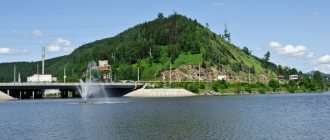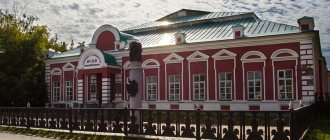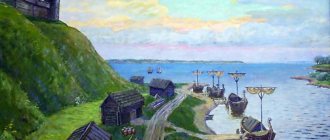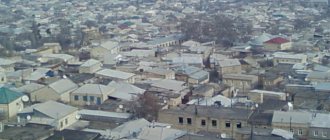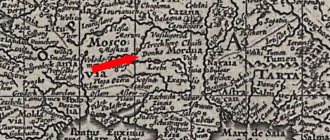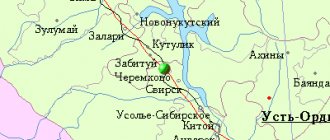Naryn-Kala fortress. Photo: pro-derbent.ru
House of Peter I. Photo: pro-derbent.ru
Naryn-Kala fortress. Photo: pro-derbent.ru
Naryn-kala citadel
In the 6th century, Sultan Khasrov the First ordered the construction of a powerful and reliable fortress on one of the hills of the Dzungarian ridge in such a way that it would block the passage to Transcaucasia. So this citadel appeared on 465 hectares, inside which a large container was built to store fresh water, which made it possible to withstand a long siege. Nevertheless, the impregnable fortress was defeated several times in its history.
The main attractions of Derbent: TOP-3
The unique sights of Derbent are considered the hallmarks of the ancient Dagestan polis. These historical monuments are truly priceless.
Naryn-Kala Citadel
- Opening hours: daily, in summer from 9:00 to 18:00, in winter from 10:00 to 16:00.
- Ticket price: adult 150 rubles, children 50 rubles.
- Telephone.
- Website: https://narin-kala.ru
- Address: st. Rzaeva, 7. Transport stop "Bayat-Kapy".
The main link of a powerful defensive system that protected Transcaucasia from attacks by nomads from the northern lands for almost 1000 years was the Naryn-Kala citadel. The garrison of the fortress, built on a high hill near the Dzhalgan ridge, could withstand a long siege. The dimensions of the fortification are impressive. It covers an area of about 4.5 hectares. The fortress is surrounded by high walls with towers. The citadel, built in the 6th century. at the behest of Sultan Khosrow I, it withstood many sieges, however, its garrison was forced to capitulate several times. So, in 1796 Naryn-Kala fell to the troops of the Russian commander, Chief General V. Zubov.
Details about the Derbent fortress
Khan's Palace
- Address: Naryn-Kala fortress. Transport stop "Bayat-Kapy".
The colorful building is considered the main architectural pearl of Derbent after the ancient fortress. The palace was erected in the last third of the 18th century. for the powerful Crimean Khan Fet-Ali, who made the complex of buildings his main residence. Most of the structures of the unique architectural ensemble have not survived to this day. However, even today you can admire the elegant portal of the main entrance to the palace and other traces of its former splendor.
Derbent wall
- Address: from the Naryn-Kala citadel to the coast along K. Mamedbekov Street.
The name of the city literally translates from Persian as “Narrow Gate”. Indeed, the width of the passage between the Caspian Sea and the spurs of the mountain range here is only 3600 m. Only through Derbent was it possible to get from Asia to the Caucasus by land in the Middle Ages. To protect the empire from attacks by warlike neighbors, the sultans from the Sassanid dynasty erected a fortress in a strategically important place, and the isthmus itself was blocked with a powerful double wall made of stone blocks. 73 towers protected the approaches to the fortifications. The height of the masonry is about 12 m. Interestingly, it runs not only on land, but also on the seabed. The walls, cutting 500 m into the waters of the bay, reliably protect the entrance to the city harbor.
Juma mosque
The oldest mosque in what is now Russia was built in the seventh century. It survived not only numerous destructions as a result of earthquakes and wars, but also restructuring. Now the length of the complex is 67 meters; you can enter the courtyard through any of the nine gates. The Baku architect Taj ad-Din ben Moussa was the author of this impressive mosque with a dome of 14 sides rising 17 meters and 46 towers.
Once upon a time, in the hard days, Houses knew how to repel enemies, Shoulder to shoulder, like warriors, they, Closed ranks, have been standing since those long ago.
The layout of Old Derbent today is the same as it was three hundred years ago. You can get to the upper city from the middle and lower, port parts, through the Northern or Southern Gates. The historical center starts from Gagarin Street, from the Gate of Stone, in Arabic Dash-Kapy. In the sixties of the last century, they were closed to the public, but looking around, you can immediately understand that the historical center begins behind these walls.
North side of Derbent
Other gates lead to Old Derbent: Kirkhlyar-Kapy, Kizlyar, or large Gate, Bayat-Kapy - Gate of Letters. And the largest, Orta-Kapy - the Middle Gate. You can climb the fortress wall and see the entire city at a glance. All gates are functioning portals for vehicles and pedestrians.
Derbent is famous for the Muslim cemetery Kirkhlyar, located right in the city. It’s strange to see tombs here, but it’s even stranger to feel an attractive desire to wander around the graves for a little longer. Stone grave stelae, carved with inscriptions and ancient patterns, circle around.
Forty Arab martyrs are buried here.
According to Derbent legend, they arrived in the city at the beginning of the 7th century. The banner of the new religion of Islam fluttered high above them. They did not preach their sermon for long; they were soon killed. But after the adoption of the new faith by the residents of Derbent, the Dagestanis hold the graves of martyrs in special respect. People died for their faith, and this is valuable.
The houses here are one-story, stone, there are no high-rise buildings at all - they stuck to each other like swallows' nests, leaving almost no passage.
Derbent, North side along
the narrow streets have no names. If the mahal is large, it is simply called - street 3 magal, 2 magal. You can see signs on the houses: 2 mahal, block 128, house number 8. Or even simpler - 8-148. They say that the number of houses increases from the bottom of the city upward. But don't be fooled.
Finding a house by its number is almost impossible; the buildings are scattered in a chaotic order, which only local residents can understand.
By the way, they are always ready to help. At the same time, you will definitely be invited to the courtyard, where you will be offered a cup of delicious aromatic tea and told many details not only from the history of your ancestors, but also quite modern city gossip.
Each house is surrounded by a stone fence, but this does not prevent residents from spending most of their time outside. Children kick a ball, old people play backgammon or dominoes for hours, sedately drinking tea from an old samovar with crushed sugar. Women spend hours having such verbal altercations that the coolest rapper would envy them.
Magals of Derbent
As you approach the sea, the slopes become steeper, the sidewalks give way to stone steps. Each mahal necessarily has its own small mosque, more like a house of worship than a majestic temple, and its own spring, from where the local population collects water directly into buckets or plastic bottles. The Old City has the largest number of mosques, as it was thousands of years ago.
There is another type of historical buildings - women's and men's baths, reminiscent of ordinary residential buildings.
Once a day, a garbage truck barely squeezes into the mahal, but it’s better not to risk it for a stranger. It’s easy to get stuck in a passenger car, so the main transport in Old Derbent is motorcycles or scooters. Putting a car in “parking” means parking it in a “pocket,” which is what they call a recess in a stone fence near the yard. This is a mandatory rule for local men. They know very well what a “traffic jam” is when there are only two cars on one street.
Church of the Holy All-Savior
The stone Armenian Christian church was built at the end of the 19th century in honor of the Bishop of Iberia and Albania on the site of an old wooden chapel. The temple is located in the village of Nagdi, half an hour’s drive from Derbent. The impeccable architecture typical of Armenian religious temples attracts attention. Now there are no regular services, the temple is slowly restoring its activity.
How to get there
From central Russia, the easiest way to get to the historical landmark is for Muscovites; they can travel the whole way by rail. Direct train No. 133M leaves from the capital’s Paveletsky station daily (at 19:27) to Derbent. The travel time is 44 hours, the ticket costs 3500–5500 rubles.
If you arrived in Makhachkala by plane, you can leave in the Derbent direction:
- By train. Electric trains leave from the Makhachkala railway station at 8:30, 9:00, 12:45, 17:45; a ticket costs 133 rubles.
- Bus or minibus. You shouldn't count on transit buses or early morning flights. It’s easier to go south by minibus. They leave from three bus stations in Makhachkala (North, South, Novaya) every 30 minutes. Minibus drivers do not adhere to a strict schedule; the minibus leaves when it is full. The cost of travel by minibus and bus is 650–700 rubles, travel time is about 3 hours.
- Taxi. By taxi you can go south directly from Uytash airport without stopping in Makhachkala. The cost of the trip depends on the carrier and the class of car and usually ranges from 2200–3200 rubles.
The distance from the railway station to the gates of the Naryn-Kala fortress is 3 kilometers. This path can be walked in 40 minutes.
Motorists traveling around Dagestan in their own car can find out how to get to the Old Town in Derbent using a navigator or electronic maps Google Maps and Yandex. To get to the historical landmark, motorists need to travel south from Makhachkala along the E119 highway. After passing Kaspiysk, Izberbash, Mamedkala, you will see the Northern Fortress Wall, in front of which you need to turn right onto Omar Khayyam and Gagarin streets.
You will reach the gates of Naryn-Kala along Buinaksky Street. The entire journey from Makhachkala (130 km) will take no more than three hours.
Church of the Intercession of the Blessed Virgin Mary
The only Orthodox church in the city was built at the end of the 19th century as a parish school. A little later a church and a bell tower were built. After the revolution until 1943, the temple was inactive. Now the church has a new iconostasis and all the required services for parishioners are held.
Synagogue "Kele-Numaz"
The multinational city allowed various religious communities to build their own churches, so in 1914 a synagogue appeared in the Jewish quarter. A little over ten years ago, the building needed serious restoration, and it was done in an interesting way. The structure was completely dismantled and rebuilt using modern and some old materials. This way we managed to preserve the historical appearance.
Lezgin Drama Theater
At the beginning of the last century, the first theater group appeared in the city, whose performances took place in villages and fortresses. For a long time, only men could visit them because the clergy opposed allowing women there. In 1928, the circle received its own building and began to be called a theater. Now it is the favorite theater of the townspeople.
House of Peter I
In 1772, Peter the Great, while making a Persian campaign with his army, stopped in Derbent and lived in an ordinary dugout. In 1872, a glass pavilion was erected on this site above the foundation of that same dugout. But time and the consequences of the revolution almost destroyed this structure. Subsequently, a new pavilion with columns and a museum appeared. The last restoration was in 2015.
Derbent is the most ancient city in Russia.
Derbent is located on the shores of the Caspian Sea, near the mouth of the Samur River, in the spurs of the Tabasaran Mountains of the Greater Caucasus. This is the southernmost and most ancient city in Russia with a population of more than 122 thousand people. This is the second largest and most important city in Dagestan, a unique museum-reserve. Derbent is translated from Persian as “closed gate”. The city received this name due to the fact that it was created as a powerful eastern fortress, consisting of the Naryn-Kala citadel and two stone walls that extend to this day through the entire city into the sea, thereby protecting the city from the south and north.
Derbent is the southernmost city in Russia.
Derbent is one of the oldest “living” cities in the world. The first settlements arose here in the Early Bronze Age - at the end of the 4th millennium BC. Around the 2nd century BC. e. On the site of the nomadic settlement of the Massagetae tribes, a city known as Chola was built. In the 6th century, the Sasanian Shah Khosrow Anushirvan changed the name of the fortress to Derbent. In the 7th century, the Arabs invaded the city, building the Juma Mosque here, and turning it into one of the main Caucasian centers of their influence. In the 11th century, Derbent was conquered by the Seljuk Turks, and in the first half of the 13th century, the Tatar-Mongol horde came here, and under its yoke the city lost its former strength and prosperity.
Derbent history of the city.
In the second half of the 17th century, the Cossack Stenka Razin took Derbent by storm. But already in the 18th century, it became difficult to hold the city under pressure from the Persians and Turks, and Peter the Great sent a flotilla here, as a result of which, under a peace treaty with the Persians, Russia officially took possession of Derbent. But after 13 years the city was transferred to Iran. In 1796 the city was conquered by Russian troops and only in 1813 it was annexed to the Russian Empire. Since the 1840s, Derbent experienced rapid economic growth, and horticulture, viticulture and fishing were also developed. In 1898, the Petrovsk-Port (Makhachkala) - Baku railway was built through Derbent.
Derbent is a city on the shores of the Caspian Sea.
Derbent is located on the very shore of the Caspian Sea, which is much shallower than the Black Sea, and therefore warms up faster. The swimming season here opens in early June. In the summer months, the air warms up to 35 degrees, and the water temperature on the hottest days can reach 28–29 degrees. In Soviet times, Derbent was famous for its sanatoriums, tourist centers and local hospitality. Military conflicts in the republics bordering Dagestan in the 90s practically brought to naught all tourist flows to the Russian Caspian Sea. After the situation in the Caucasus stabilized, the infrastructure of the city and region began to actively develop again: road repairs, construction of hotels, hotels with swimming pools, development of beaches, opening of restaurants and cafes.
Derbent Naryn-Kala Fortress.
Local residents say that anyone who has not visited the Naryn-Kala citadel has not been to Derbent. This famous ancient Derbent fortress, which turned the city into a “Closed Gate,” rises above Derbent from the mountain. Its double walls, which descended to the Caspian Sea itself, made it possible to completely control the narrow coastal passage from the sea to the south, to Persia. The fortress was protected on three sides by steep mountain cliffs, and towers were built within the walls at a distance of about 25 meters from each other.
Naryn-Kala fortress.
Inside, there are water tanks in case of a siege, the khan's baths and the office of the 18th century, which today is occupied by the Ancient Derbent Museum, as well as the guardhouse building built in 1828, where an art gallery with an exhibition dedicated to the history of the city is open. Among the ruins of ancient buildings are the remains of a 4th century Christian church, which was then converted into a Zoroastrian sanctuary and later into a mosque. This church is considered the first Christian temple in the country.
Naryn-Kala.
The Dag-Bara wall was originally built around the 6th century and in some sources was called the “Great Caucasian Wall” - which is understandable and true. The monumental structure, 42 km long, stretched through groves and hills and into the mountains; it was impossible to get around it. The wall was made of shell rock, and forts with turrets were built along its entire length. The wall saved the inhabitants of Western Asia from the attacks of nomadic tribes, but already in the Middle Ages it lost its significance. Today, less than a third of the original structure remains.
Fortress in Derbent.
Naryn-Kala, together with the Dag-Bary wall, today remains one of the largest defensive structures in the world. They are part of the Derbent State Historical, Architectural and Art Museum-Reserve and are included in the UNESCO World Heritage List. The fortress is located in the western part of the city and is clearly visible from afar. You can climb up to it via a long staircase on foot or drive up to the main gate by car. Public transport does not go here.
Derbent lighthouse.
Derbent has been a seaport since ancient times: even before the Persians and before the construction of its famous fortress. The first written mention of the harbor can be found only in Arab written sources of the 9th-10th centuries, but you will not find a word about the lighthouse in them. In 1866, a lighthouse about 18.5 meters high was built on the northeastern wall of Naryn-Kala, about half a kilometer from the coastline. It was made in the form of a simple octagonal tower with a wooden lantern. The Derbent lighthouse is still in operation today: in 2007, a new bright light source was installed on it. Its signal is visible at a distance of up to 18 nautical miles. The lighthouse in Derbent is considered the southernmost lighthouse in the country and is included in the list of protected monuments. It can be seen from Sovetskaya Street, if you walk past Kirov Park towards the sea.
Derbent Juma Mosque.
The oldest mosque in Russia was built in 734. At that time, Derbent already had seven mosques, one for each district of the city. The Juma Mosque became the main mosque; it was here that the townspeople performed Friday prayers. The mosque is well preserved and was recently included in the UNESCO List of Heritage Sites. Over the centuries, the mosque was rebuilt several times. Gradually, the mosque was “overgrown” with additional buildings: a madrasah began to be built next to it, and the complete architectural complex was formed only by 1815. The largest in the North Caucasus and for a long time the only one in Southern Dagestan, the Juma Mosque attracted Muslims not only from Derbent, but also from numerous surrounding areas.
Derbent Juma Mosque.
In the courtyard of the Juma Mosque there are three patriarchal plane trees (in the Eastern tradition they are called plane trees), which rise above the walls and are clearly visible from many parts of the city. In 2012, these thousand-year-old giants were recognized as natural monuments and protected by the state. All the main buildings of the complex have survived to this day: the main building of the cathedral mosque, the madrasah and residential buildings. The mosque itself is a structure of three parts 68 meters long with a dome 17 meters high. The Juma Mosque is located in the Old City, in a confusing maze of streets. If you believe the residents of Derbent, then all of them, one way or another, lead to the mosque.
Peter's house in Derbent.
The opening of the newest museum in Derbent took place in the summer of 2015 and was timed to coincide with the celebration of the 2000th anniversary of the city. Tsar Peter was in the Caspian lands when he led the Persian campaign, which ended in Derbent in 1722. Pyotr Alekseevich was always famous for his love for the soldier’s simplicity of life and for several weeks spent in Derbent he lived in a simple dugout, and at the beginning of the 19th century a pavilion with columns and a memorial inscription above the entrance was built on top of it.
Derbent State Museum-Reserve.
The first local history museum on the territory of Derbent was founded in 1926 and became the main attraction of the city. The museum occupies a huge area - more than 2 thousand hectares. In the reserve you can see more than 250 historical and cultural monuments from the 4th to 20th centuries. They are considered archaeological values, as they represent residential buildings and public buildings of ancient Dagestan. Every year the ancient museum becomes more and more popular for tourists from different parts of the world. Inside the fence there are a large number of museums that are part of this reserve. These are buildings from different times that represent historical facts, carpet art, culture and household items. There is also a huge assortment of exhibits of military glory that are interesting to view while studying the events of the war.
Carpet Museum in Derbent.
Many tourists consider this museum the most interesting in Derbent. It was opened in 1982 in the building of an old Armenian church, which was built in the city center in 1870. During the Civil War, the beautiful structure made of hewn shell rock lost almost its entire upper part. Only in 1976, after it was recognized as an architectural monument, work began on its restoration. The restored church was transferred to the Derbent State Museum-Reserve, of which the Carpet Museum became a part.
Derbent Cognac Factory.
The enterprise was built back in 1902 as a factory, and in 1960 it became a plant where various brands of cognac are produced. The plant is a full-cycle enterprise - from growing grapes to producing finished cognac. This is a real creative workshop where experienced professionals create real masterpieces. The plant's products are widely represented in many regions of Russia - from Moscow to the Far East. A wide dealer sales network has been established in the Moscow and Rostov regions.
How to get to the city of Derbent.
For time lovers, it is best to choose a plane. Derbent does not have its own airport. You can fly from Moscow to Makhachkala, and then travel 120 kilometers to Derbent along the highway. There are route and bus services between the cities. Travel time is just over 2 hours. The distance from Moscow by rail is 2212 kilometers. The Moscow-Baku fast passenger train, which runs through Volgograd and Astrakhan, takes 48 hours to Derbent station.
Carpet and Decorative Arts Museum
It was decided to convert the empty building of the former Armenian church from the late 19th century into a carpet art museum in 1982. But besides this, here you can see exhibits made of silver, wood and other materials made by local craftsmen in past centuries. Jewelry and weapons are the real wealth and pride of the museum.
Museum of Culture and Life of Ancient Derbent
The museum is located in the premises of former women's baths built in the 17th century. An interesting fact is that only unmarried girls could visit them; a secret ritual of preparation for future family life was held here. A well-thought-out ventilation system made it possible to warm up the fonts and pools with relaxation rooms. The last restoration in 1992 made it possible to preserve the entire interior decoration.
Museum of the History of World Cultures and Religions
The new museum appeared in 2014 and is intended to tell about the time when the city was multinational and crowded. Here you can see all the national costumes typical of the townspeople, household items and paintings reflecting life in the ancient city. Excursions are often held for children of primary and secondary school age.
The oldest city in Russia
Like most cities of the early historical period, Derbent was built near the fortress walls surrounding the citadel. Fortress, castle, kremlin, detinets - all these names in different regions designate the center of a fortified settlement protected by a fortress wall, from which the city subsequently grew. Representatives of the ruling power lived inside the citadel, and the military-administrative center was located. Here, in the event of a siege, residents of the outer city neighborhoods could take refuge.
© Julia Alisova
Two defensive walls, stretching 3600 m from the fortress standing on a hill, went straight into the sea. They blocked the path through the narrow passage of the Caucasian Gate to any uninvited guests and conquerors, and allowed them to control the movement of goods. The walls were made of unbaked brick and cut stone. Fourteen gates were built in them, but only nine have survived to this day. A convenient sea harbor was formed in the protected space between the walls, and residential areas began to be built.
Medieval buildings that arose at the foot of the fortress walls occupied the slope facing from the citadel to the seashore. Narrow streets formed compact areas, the so-called “magals”. There are 9 mahals in Old Derbent. Residential buildings were grouped around the center of the block, each with its own mosque, water tanks, and baths.
© Nikolay Lebedev
Over the centuries, the houses have been rebuilt many times, but many of them have retained their archaic appearance and stand on ancient foundations. Some families living in the old quarters have still lived in the same place for several centuries. The old city of Derbent, together with the citadel and fortress walls, is recognized as a UNESCO cultural heritage site and is considered one of the most ancient cities in Russia.
House-Museum of Bestuzhev-Marlinsky
An ordinary 17th-century town house has been turned into a museum telling the biography of Alexander Bestuzhev-Marlinsky, a famous ethnographer, writer and revolutionary. It was his works that made it possible to preserve memory and information about how they lived in Dagestan in the last century.
Where is the Old Town in Derbent
On a paper or electronic map of Russia, the oldest city in Dagestan should be looked for on the western coast of the Caspian Sea, 130 kilometers south of the capital of the republic.
If you don’t know how to find the Old Town of Derbent on the map, enter the geographic coordinates 42.0765006418, 48.2793561753 into your navigator. For tourists, the eastern border of the historical center will be Salman Street, lined with modern high-rise buildings. In the west, the back wall of the Naryn-Kala fortress became the border of the historical part; there are no city buildings behind it. From the south, the Old City ends on Tagi-Zade Street, from the north - on Kerim Mamedbekov Street.
Park of Military Glory
In 2015, for the 70th anniversary of the victory in the city, a large-scale reconstruction of the city park was carried out. As a result, a memorial complex appeared with an eternal flame and a sculpture of a woman praying for salvation, personifying the Motherland grieving for those killed in the war. Three cranes hovering above her head symbolize the souls of the defenders of the fatherland during the war.
History of Derbent
The ancient origin of Derbent is associated with its strategic location. The fortress with a settlement near it closed a narrow passage to the Caucasus from the Caspian Sea and Persia on the Great Silk Road. Therefore, all the names of the city include the word “gate” - Darband (in Persian “closed gate”), Bab al-Abwab (in Arabic “gate of the gate”), Temir Kapu (in Turkish “iron gate”).
The Naryn-Kala fortress was built by the Persians in 438. By 529, the mud brick walls were replaced by stone masonry. Before the construction of the fortress, Rome, Parthia, and Byzantium tried to conquer this region. The Armenians and Khazars tried to take the powerful fortification.
Subsequently, the fortress was successfully stormed by the Western Turks (626), the Arab Caliphate (643), the Seljuks (1075), and Tamerlane (1395). Naryn-Kala was also taken by storm by Stepan Razin (1668). Derbent first went to Russia under a peace treaty with the Persians (1723), but was then captured by Iran. Dagestan finally became part of the Russian Empire in 1813.
Derbent embankment
A beautiful embankment with many walking areas and places for recreation and entertainment with children was equipped for the 2000th anniversary of the founding of the city. The total area is approximately 7.5 hectares, and the length of the embankment is almost a kilometer.

